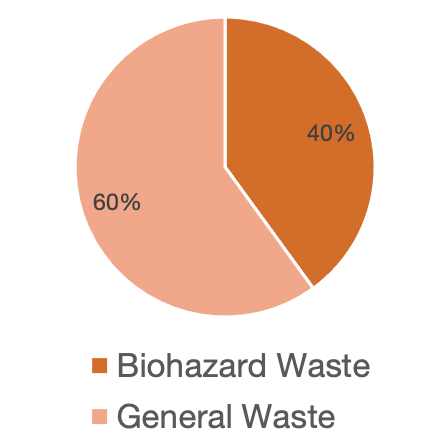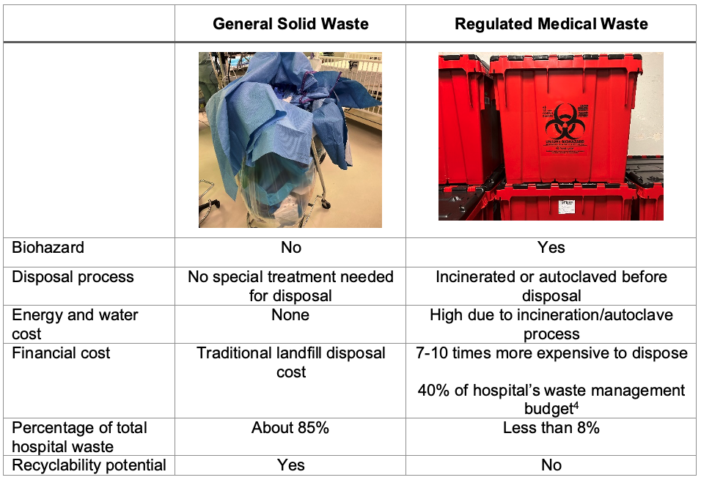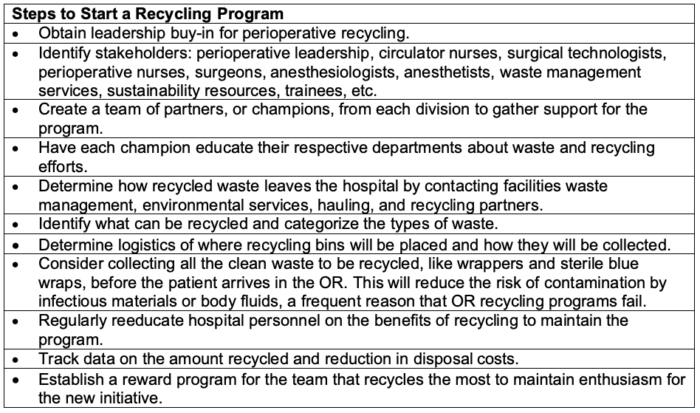Copy link
Recycling in the Operating Room
Last updated: 08/09/2023
Key Points
- Operating rooms (OR) produce more than 30% of a hospital’s total waste and can comprise up to 40% of a hospital’s waste management budget.1
- Lack of knowledge about which materials are recyclable is a major barrier to OR recycling.
- Establishing an OR recycling program requires multiple personnel, partnerships with recycling companies, and enthusiasm for the program by stakeholders.
Introduction
- Hospitals in the United States produce about 5 million tons of waste per year, and 30% of it originates in the ORs.1,2 About 85% of this waste is general solid waste, and 15% is regulated medical waste (RMW). However, the cost of RMW makes up about 40% of the entire hospital waste management budget (Figure 1).1
- A large percentage of this general solid waste comes from medical plastics used as packaging material for OR equipment and supplies. “Blue wrap,” a medical plastic used to maintain sterility, is about 20% of the total OR waste.3
- Appropriate segregation of general solid waste in ORs into true waste and recyclable materials can reduce both the cost of discarding the waste and its harmful impact on the environment.

Figure 1. Distribution of hospital waste budget
Regulated Waste vs. General Solid Waste
- ORs produce approximately 26% of the general solid waste and 60% of the RMW generated by the hospital.3 General solid waste is not contaminated by infectious materials, so it can be disposed in landfills or recycled without any special treatment. RMW, or biohazardous waste, includes sharps, pharmaceuticals, and waste that is contaminated by potentially infectious materials or saturated with blood. This waste cannot be recycled and often is incinerated or autoclaved, which is energy intensive. Table 1 highlights the key differences between general solid waste and RMW.
- Although ORs produce about 60% of the entire hospital’s RMW, in one study, 90% of the waste found in biohazard bags in ORs did not meet the criteria for biohazard waste, and a substantial portion of this waste could be recycled instead.5
- The Centers for Disease Control and Prevention suggests that only 2-3% of a hospital’s waste needs to be classified as RMW.1 Reducing RMW allows more materials to be potentially recyclable and reduces the financial and energy cost of RMW disposal by 7-10 times.

Table 1. Differences between general solid waste and regulated medical waste.
Identifying Recyclable Plastics in the Perioperative Area
- Medical plastics make up the largest portion of waste that can be recycled from ORs. Plastics are labeled #1-7 in accordance with the Resin Identification Coding (RIC) system and segregated based on this number when recycled.3
- Many recycling programs may only accept items that have a recycling code on them, although many items from the OR are theoretically recyclable. Contaminated items may not be recycled, but opened, unused items are allowed to be recycled.
- Table 2 shows examples of different plastics in the OR that may be able to be recycled, depending on facilities in the area.3,7

Table 2. Types of recyclable plastics in the OR
Establishing an OR Recycling Program
Establishing an OR recycling program requires multiple personnel, partnerships with recycling companies, and enthusiasm for the program by stakeholders (Table 3).6

Table 3. Steps to start a recycling program
OR Recycling Program Challenges
One of the greatest barriers to recycling in the OR is the lack of knowledge regarding which materials can be recycled.5 Additional challenges are listed below:
- Obtaining leadership buy-in to implement the recycling program
- Finding designated space in the OR for collecting recycling waste
- Obtaining easily accessible, properly labeled recycling bins
- Preventing the inadvertent release of regulated infectious material to recycling partners
- Acquiring personnel to be responsible for collecting and separating recycling material from the perioperative area
- Maintaining the program with education and follow-up
References
- Axelrod D, Bell C, Feldman F, et al. Greening the operating room and perioperative arena: Environmental sustainability for anesthesia practice. American Society of Anesthesiologists. Published October 2014. Accessed October 13, 2022. Link
- McGain F, Jarosz KM, Nguyen MN, et al. Auditing operating room recycling: A management case report. A A Case Rep. 2015;5(3):47-50. PubMed
- Greening the OR. Practice Greenhealth. Accessed October 13, 2022. Link
- Regulated medical waste. Practice Greenhealth. Accessed October 13, 2022. Link
- Azouz S, Boyll P, Swanson M, et al. Managing barriers to recycling in the operating room. Am J Surg. 2019;217(4):634-8. PubMed
- Gentry K, Hansen E, Mohammad S. OR Recycling Checklist. Society for Pediatric Anesthesia. Published August 2021. Accessed October 22, 2022. Link
- Xiao MZX, Abbass SAA, Bahrey L, et al. A roadmap for environmental sustainability of plastic use in anesthesia and the perioperative arena. Anesthesiology. 2021;135(4):729-37. PubMed
Other References
- Healthcare Plastics Recycling Council. Environmental Impacts of Recycling. Accessed: August 9, 2023. Link
- Axelrod D, Bell C, Feldman J, et al. Greening the Operating Room. American Society of Anesthesiologists. Accessed: August 8, 2023. Link
- Practice Greenhealth. Greening the Operating Room. Accessed: August 9, 2023. Link
- CleanRiver. 6 Steps to Start a Hospital Recycling Program. Accessed: August 9, 2023. Link
- Practice Greenhealth. Medical Plastic Recycling. Accessed: August 9, 2023. Link
- Health Care Without Harm. Accessed: August 9, 2023. Link
- Plastics and health. Health Care Without Harm. Published: November 2022. Accessed: August 9, 2023. Link
Copyright Information

This work is licensed under a Creative Commons Attribution-NonCommercial-NoDerivatives 4.0 International License.